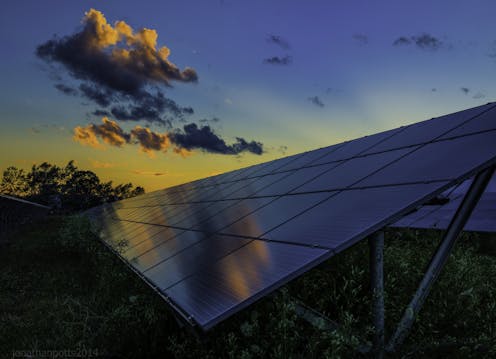Australia is not on track to reach 2030 Paris target (but the potential is there)
- Written by Anna Skarbek, CEO at ClimateWorks Australia, Monash University

While Australia is coming to terms with yet another new prime minister, one thing that hasn’t changed is the emissions data: Australia’s greenhouse gas emissions are not projected to fall any further without new policies.
Australia, as a signatory to the Paris Agreement on climate change, has committed to reduce its total emissions to 26-28% below 2005 levels by 2030, and reach net zero emissions by 2050.
Read more: Why is climate change's 2 degrees Celsius of warming limit so important?
New analysis by ClimateWorks Australia has found Australia has three times the potential needed to reach the federal government’s current 2030 target, but this will not be achieved under current policy settings.
Energy is not the only sector
Australia’s emissions were actually falling for more than half a decade, but have been steadily increasing again since 2013. If Australia sustained the rate of emissions reduction we achieved between 2005 and 2013, we could meet the government’s 2030 target. But progress has stalled in most sectors, and reversed overall.
Emissions are still above 2005 levels in the industry, buildings and transport sectors, and only 3% below in the electricity sector. It is mainly because of land sector emissions savings that overall Australia’s emissions are on track to meet its 2020 target, and are currently 11% below 2005 levels.
Despite the current focus on the energy market, electricity emissions comprise about one-third of Australia’s total greenhouse emissions. So no matter what policies are proposed for electricity, other policies will be needed for the other major sectors of industry, buildings, transport and land.
Fortunately, Australia is blessed with opportunities for more emissions reductions in all sectors.
Read more: Keeping global warming to 1.5 degrees: really hard, but not impossible
ClimateWorks’ analysis assessed Australia’s progress on reducing emissions at the halfway point from the 2005 base year to 2030, looking across the whole of the economy as well as at key sectors.
We found emissions reductions since 2005 have been led by reduced land clearing and increased forestation, as well as energy efficiency and a slight reduction in power emissions as more renewable energy has entered the market. But while total emissions reduced at an economy-wide level, and in some sectors at certain times, none of the sectors improved consistently at the rate needed to achieve the Paris climate targets.
Interestingly, some sub-sectors were on track for some of the time. Non-energy emissions from industry and the land sector were both improving at a rate consistent with a net zero emissions pathway for around five years. The buildings sector energy efficiency and electricity for some years improved at more than half the rate of a net zero emissions pathway. These rates have all declined since 2014 (electricity resumed its rate of improvement again in 2016).
Looking forward
Looking forward to 2030, we studied what would happen to emissions under current policies and those in development, including the government’s original version of the National Energy Guarantee with a 26% emission target for the National Electricity Market. Our analysis shows emissions reductions would be led by a further shift to cleaner electricity and energy efficiency improvements in buildings and transport, but that this would be offset by population and economic growth.
As a result, emissions reductions are projected to stagnate at just 11% below 2005 levels by 2030. Australia needs to double its emissions reduction progress to achieve the federal government’s 2030 target and triple its progress in order to reach net zero emissions by 2050.
So, while Australia is not currently on track to meet 2030 target, our analysis found it is still possible to get there.
Read more: What is a pre-industrial climate and why does it matter?
The gap to the 2030 target could be more than covered by further potential for emissions reductions in the land sector alone, or almost be covered by the further potential in the electricity sector alone, or by the potential in the industry, buildings and transport sectors combined. Harnessing all sectors’ potential would put us back on track for the longer-term Paris Agreement goal of net zero emissions.
Essentially this involves increasing renewables and phasing out coal in the electricity sector; increasing energy efficiency and switching to low carbon fuels in industry; increasing standards in buildings; introducing vehicle emissions standards and shifting to electricity and low carbon fuels in transport; and undertaking more revegetation or forestation in the land sector.
The opportunities identified in each sector are the lowest-cost combination using proven technologies that achieve the Paris Agreement goal, while the economy continues to grow.
Read more: Australia can get to zero carbon emissions, and grow the economy
In the next two years, countries around the world, including Australia, will be required to report on the progress of their Paris Agreement targets and present their plans for the goal of net zero emissions. With so much potential for reducing emissions across all sectors of the Australian economy, we can do more to support all sectors to get on track – there is more than enough opportunity, if we act on it in time.
Authors: Anna Skarbek, CEO at ClimateWorks Australia, Monash University



